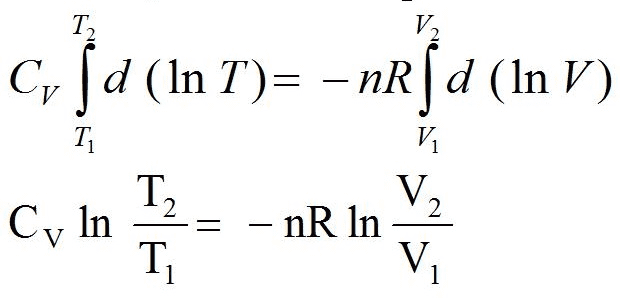cyclic process
Consider an ideal gas with molar constant volume heat capacity, cV,m = 1.50 R. The gas undergoes the reversible four step cyclic process shown to the left: 1. During step 1, the gas expands isothermally from V1 to V2. 2. During step 2, the gas expands adiabatically from V2 to V3. 3. During step 3, the gas is compressed isothermally from V3 to V4. 4. During step 4, the gas is compressed adiabatically from V4 to V1. Given T1 = 350.0 K, P1 = 1.00 Ã 105 Pa, V1 = 5.82 Ã 10-2 m3 , V2 = 10.0 Ã 10-2 m3 , T3 = 175.0 K,
Perform the following calculations:
a. Determine the pressure, volume, and temperature of the gas at equilibrium points 1, 2, 3, and 4.
b. Calculate the work done on the gas during each step.
c. Calculate the transfer of energy into the gas as heat during each step.
d. Calculate the change in energy of the gas during each step.
e. Calculate q, w, and ÎU for the entire cyclic process.
f. Determine the enthalpy of the gas at equilibrium points 1, 2, 3, and 4.
g. Calculate the change in enthalpy of the gas during each step.
h. Calculate ÎH for the entire cyclic process.
i. Calculate the change in entropy of the gas during each step.
j. Calculate the change in entropy for the entire cyclic process
cyclic process
Consider an ideal gas with molar constant volume heat capacity, cV,m = 1.50 R. The gas undergoes the reversible four step cyclic process shown to the left: 1. During step 1, the gas expands isothermally from V1 to V2. 2. During step 2, the gas expands adiabatically from V2 to V3. 3. During step 3, the gas is compressed isothermally from V3 to V4. 4. During step 4, the gas is compressed adiabatically from V4 to V1. Given T1 = 350.0 K, P1 = 1.00 Ã 105 Pa, V1 = 5.82 Ã 10-2 m3 , V2 = 10.0 Ã 10-2 m3 , T3 = 175.0 K,
Perform the following calculations:
a. Determine the pressure, volume, and temperature of the gas at equilibrium points 1, 2, 3, and 4.
b. Calculate the work done on the gas during each step.
c. Calculate the transfer of energy into the gas as heat during each step.
d. Calculate the change in energy of the gas during each step.
e. Calculate q, w, and ÎU for the entire cyclic process.
f. Determine the enthalpy of the gas at equilibrium points 1, 2, 3, and 4.
g. Calculate the change in enthalpy of the gas during each step.
h. Calculate ÎH for the entire cyclic process.
i. Calculate the change in entropy of the gas during each step.
j. Calculate the change in entropy for the entire cyclic process

